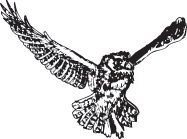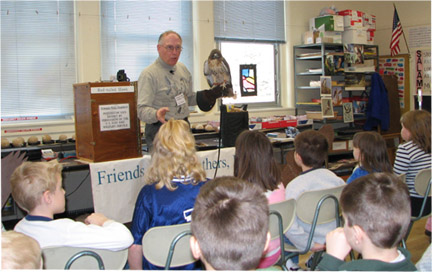

How Friends With Feathers Came to Be - And What it is Now
Walker decided to apply for the required federal and state permits to enable him to continue the programs on his own. To support the owls, he started doing outreach programs for youth/adult groups and asking for donations. All fees and donations are used to house and feed the Friends With Feathers raptors. An injured male barred owl, a female great horned owl, two screech owls and a female red-tailed hawk were Walker's first ambassadors.
After more than 30 years of hosting live bird shows to students and adults in western and central New York, Ron retired in the summer of 2012. With Friends With Feathers he had have given more than 3,200 presentations before an audience of 300,000+ people.
The hawks, owls and turkey vulture in the Friends with Feathers aviary were transferred to other educational facilities. (Click here for a list of these facilities.) Ron continues to share his love of nature and these majestic birds with the public through slide presentations and question-and-answer sessions.
'Non-releasable' and why the birds aren't given pet names
When rehabilitators and veterinarians treat injured raptors they have some that will not ever be able fly or see and hear on one side of their head.
Birds with these kinds of injuries will never be able to hunt or escape predation. They need to be cared for the rest of their lives. In these situations the rehabilitators and veterinarians contact zoos and wildlife educators looking for a home for the non-releasable raptor.
Once a home is located, a letter is sent to the United States Fish and Wildlife Service and the New York State Department of Environmental Conservation requesting permission to acquire the permanently injured raptor.
As part of the training to do programs at the Cumming Nature Center, The Rochester Museum and Science Center sent Walker and several co-workers to visit the San Diego Zoo and to the San Diego Wild Animal Park for a week. The record-keeping charts and some of the philosophies used by Friends With Feathers have been derived from what was learned on that trip.

Ron Walker introduces a Red-tail Hawk to a young class.
An example would be the common question asked during presentations: "What is the name of that bird of prey?" The name is broad-winged hawk or eastern screech-owl. Birds of prey are wild animals -- not pets. They do not want to be touched, be close to another species or often even close to their own kind!
Also by not giving the bird a pet name, the handler tends to be more alert when working with it and more apt to read its body language for possible trouble.
The reason some zoos and wildlife groups do use pet names is it's easier for the staff members to communicate about the different animals. Also, it is possible to raise funds by selling adoption papers to school classes, clubs and families.
If you are interested in a live birds of prey presentation, I suggest you contact one of the following organizations:
| Kindred Kingdoms | Jean Soprano | (315) 695-6418 |
http://kindredkingdoms.com/ |
| Wild Wings | (585) 334-7790 | www.wildwingsinc.org | |
| Institute for Environmental Learning | Ann & Paul Schnell | (585) 366-4314 | www.ielraptors.org |
Most of Friends With Feathers' raptors were transferred to Kindred Kingdoms and Wild Wings after July 1, 2012. You may see a familiar bird of prey when you schedule a program with them.